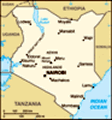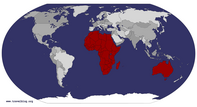Advertisement
Published: January 19th 2007
We were assured that our bus from Dar' would not only leave on time, but would take 8 hours to reach Mombasa, Kenya, the sixth country of our safari kubwa. Of course this was promised before Africa time was taken into account and after leaving only a modest hour late, we arrived in Mombasa at approximately 10pm, making it yet another 14 hour travel day. If only we didn't have to stop every 10 minutes for the driver to buy fruit or for every second passenger to load on and off their lifes possesions, or even for a border official to turn up at the border, we might have made better time. From our guidebook we chose The New People Hotel above lodgings with names such as Glory Guest House, Excellent Hotel and Evening Guest House (as opposed to Day Time Guest House), even though the book said that the noise from the street and surrounding mosques was quite substantial. What the good book failed to mention was that to the left of the hotel and in the mechanics qtr was one of the best value and tastiest street cafes we'd come across on all of our travels to date. Amazingly
thick and fresh juici ya matunda embe na pashini, (mango and passion fruit juice) chapatis, mishkaki, (meat skewers) saladi and Swahili Pizza for less than 200KSh ($4Aus). The owner of the cafe took a particular liking to our ordering in Swahili and constantly made sure that our drinks were kept topped up and that we had everything we required. Although Mombasas history dates back at least 12 centuries to when it was inhabited by the Zeng people, an African civilization, evidence suggests that it has been trading with Arabian ports for as many as 2000 years. Traditional dhows still arrive early in December on the N.E. monsoon with a cargo of dates, dried fish, carpets and chests and depart again carrying mangrove poles, ghee and citrus fruits on the S.W. monsoon in mid May. To date it is still the most important port in East Africa and goods from all over Central and East Africa pass through Mombasa before heading abroad. It has a brutal history of war and conquest and power and occupation alternated, mainly between Arabs and Persians until the 15th century when Portuguese galleons attacked and sacked the city twice. In an attempt at permanency the Portuguese

 Here's Johnny
Here's Johnny
'Uncle Johnny' was our unofficial guide and good friend in Mombasaerected Fort Jesus which to this day still guards the old port, but it quickly became a symbolic target for rebel leaders and it came under under constant attack until the 1890s when Mombasa became part of the British Protectorate. Fort Jesus was one of the main attractions we were interested in visiting, but the Kenyan government had recently increased the admission price for foreigners to a staggering 800KSh, making it way too expensive for us. Fortunately, and in true toutish style, Uncle Johnny availed us of his services and gave us an informative and fun (unofficial) tour of not only the outside and secret entrances to the fort (all of which were blocked by thick iron gates), but also into the heart of the Old Town including old slave pits, local houses, mosques and restaurants, the fabrics, fruit and fish markets, the mafia beach and even his mothers house. We spent two days hanging out with Uncle Johnny and although a couple of small donations passed hands, we totally felt that he was enjoying the friendship as much as we were. Both North and South of Mombasa the Kenyan coast is lined with white, sandy beaches and coral reefs
full of tropical marine life and game fish, however having recently spent a month on the beach in Mozambique and on Zanzibar we were keen to continue our exploration of true Swahili culture. Like Ihla do Mocambique and Unguja, Mombasas Old Town was a labyrinth of winding alleyways, spice shops, coffee vendors, mosques and historic Swahili and Arab houses with intricately carved wooden doors and balconies to protect the modesty of the female inhabitants. With and without Uncle Johnny we wandered aimlessly for a couple of days. Although Mombasa is supposedly safer than Nairobi, we were still on guard and tried to avoid being on the street at night. Having just spent a week or so in Dar' this was nothing new for us, however on the night of the Kombe la Dunia final between France and Italy we literally had to run across town after the match as all the tuk tuk and taxi drivers were obviously drunk (but still driving) after watching the game. We arrived back at our hotel just in time as the locals came out to celebrate the match and their all being Italian supporters. For the whole night we sat on our balcony watching

 Mombasa Mosque
Mombasa Mosque
Just one of the many that compltely surrounded our hotelithe frenzy of the street party as sirens, car horns and flares were constantly going off whilst Africans were dancing and head butting each other in the chest (doing the Zizou). Cars were tearing up and down the street chanting and with music blaring and occupants waving Italian flags. We were quite positive that had France of won, the same party would have erupted but the flags would instead be red, white and blue, the nation suddenly French and the Italian flags hidden under the seat. We got very little sleep that night and just to make sure that we were awake for our next mornings early departure, the mosques all seemed to welcome the new day of prayer at the normal time of 4am, but with extra vigour!
Malindi is Kenyas most popular and famous resort town and during the high season months of July and August it swarms with tourists, particularly Italian and German. Even though we visited in mid July our low budget lodging in the cntre of town and of course next to the bus station and market, Tana Guest House, afforded us some anonominity. We did however in our 2 day stay in Malindi

 Mombasa Museum
Mombasa Museum
One of several grand buildings with colonial British architecturebecome local celebrities at the Bahari Dishes cafe across from our guest house. It was a very cheap (an underlying theme in our dining choices) help yourself cafe serving all the usuals as well as lovely Pilau (goati and rice), sambusas, kebabu, chai masala and so on. Although the beaches and big hotels are the main attraction for the majority of Malindis tourists, we were there as a base to visit the near by Gede Ruins and also to break up our journey between Lamu and Mombasa and on to Nairobi. We did take an afternoon walk along the beach front and to gawk at the expensive hotels and restaurants, but we soon canned that idea. We just wanted to sit and enjoy a cold Tusker Malt and watch the kids play football on the sand, but we couldn't see two inches in front of us through all the touts competing with each other to flog us their wares. And besides, due to recent heavy rains and poor farming practices up river, the beaches and water were awash with mud and silt. This is not only a problem from an aesthetic point of view, but also because a lot of

 Football fans
Football fans
A large % of Malindis population are or atleast claim to be, Italian!the corals and marine life are being killed because of it. As for visiting the curios market, forget that. From a distance we could see the stall holders running towards us clutching their prized crafts. We walked on by. One good aspect of the large numbers of European tourists and expats however was that we were able to get a good coffee! One of the locals provided us with some comic relief when he noticed that Dani and I had gone off in separate directions for an hour or so. He raced up to Dani in a puff and pointing. "Your wife! Your wife! He went that way!"
16km South of Malindi the ancient ruins of an old Arab town set in the midst of coastal forest are to be found. It is thought that Gede was founded somewhere in the the 13th century and flourished as a trading stop in the late 14th and 15th centuries. The glassware, porcelain and ivory that has since been unearthed demonstrates the taste for luxury that the civilization enjoyed . At its peak the town was surrounded by a 2.7 metre high wall with three gates and on the inside were inner living
circles separating the different status of its occupants. It is also thought that during its prime Gede was home to over 2000 people. There are many theories as to why Gede was abandoned sometime in the 17th century including a shifting water plain meaning the town ran out of fresh water and also that the tribe moved with, or were forced out by strong arm traders. Gede was lost to the world until it was discovered in the 1920s totally overtaken by the forest. Adding to its mystique is the fact that there are no records of its existance in any historical texts. The ruins today are very well maintaned and intact and provide visitors with examples of derelict houses, ornate tombs, mosques and sanitation facilities including cisterns for ritual washing, toilets and air conditioning devices. We quadrupled the price quoted in our guide book and indeed weren't surprised to have to pay 500KSh each plus an extra 300KSh for a compulsory guide. Thankfully our guide Alphus not only spoke good English, he had a sense of humour too, continuing our good run of luck with the guides we'd had. After we'd meandered around the ruins for a couple of

 Gede Ruins
Gede Ruins
Sunshine on my windowhours we visited the museum. Thankfully there was no one there to collect another entrance fee of 100KSh. Inside the museum were models of how it is thought the town must have looked in its day and also examples of tools, weapons, jewellery and currency including silver Chinese coins indicating trade dealings also with China. On our way back to Malindi we bought some fruit from some kids who were absolutely flabbergasted that the funny looking mzungus could talk to them in their own language. The look on their faces was priceless!
Advertisement
Tot: 0.039s; Tpl: 0.012s; cc: 8; qc: 23; dbt: 0.0187s; 1; m:domysql w:travelblog (10.17.0.13); sld: 1;
; mem: 1.1mb












